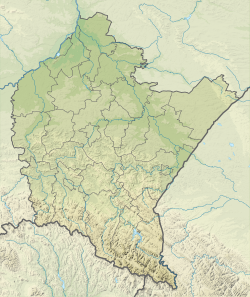For similarly named synagogues, see New Synagogue.
| New Synagogue | |
|---|---|
 The former synagogue, now library, in 2010 The former synagogue, now library, in 2010 | |
| Religion | |
| Affiliation | Orthodox Judaism (former) |
| Rite | Nusach Ashkenaz |
| Ecclesiastical or organisational status |
|
| Ownership |
|
| Status |
|
| Location | |
| Location | Juliusza Słowackiego 15, Przemyśl, Podkarpackie Voivodeship |
| Country | Poland |
 in Podkarpackie Voivodeship | |
| Geographic coordinates | 49°46′52″N 22°46′33″E / 49.781216°N 22.775930°E / 49.781216; 22.775930 |
| Architecture | |
| Architect(s) | Stanisław Majerski |
| Type | Synagogue architecture |
| Style | |
| Groundbreaking | 1910 |
| Completed | 1918 |
| Materials | Brick |
The New Synagogue, also called Scheinbach’s Synagogue, is a former Orthodox Jewish congregation and synagogue, located at Juliusza Słowackiego 15, in Przemyśl, in the Podkarpackie Voivodeship of Poland. Designed by Stanisław Majerski and completed in 1918, the synagogue served as a house of prayer until World War II when it was desecrated by Nazis in 1939.
Since 1967, the building has been used as the Ignacy Krasicki Przemyśl Public Library.
History and architecture
Construction on the synagogue began in 1910 and was completed in 1918 after delays caused by the First World War. The spacious, high-ceilinged building survives, although Communist-period renovations stripped so much of the exterior detail that it presents an appearance in marked contrast to the building shown in old photographs.
The synagogue is a free-standing brick building in an eclectic blend of Rundbogenstil and Classical Revival styles with decoration attributed to contain elements of the Baroque Revival style. Designed by Stanisław Majerski, the elaborate interior decoration once featured Biblical scenes and scenes of Eretz Israel painted on the walls and ceiling.
Reincarnated as a public library, the building's interior is sedate and functional, with bookshelves and walls painted white. The synagogue also had a notable set of stained glass windows. The windows and paintings were by Adolf Bienenstock, a Jewish Przemyśl artist who was a graduate of the Jan Matejko Academy of Fine Arts. Kraków, like Przemyśl, was then part of Austrian Galicia (also known as Austrian Poland). Bienenstock, who taught art at the Przemyśl Gymnasium, had studied under the notable Polish artist Józef Mehoffer. The interior reflected the influence of the Young Poland movement of which Mehoffer was part. Young Poland was the Polish version of the jugendstil (Art Nouveau) movement.
The synagogue was used for profane purposes including as a stable by the German army during World War II, and then later as a textile factory under the Communist post-War government, before being turned into a library in 1967.
See also
References
- ^ "New (Scheinbach) Synagogue in Przemyśl". Historic Synagogues of Europe. Foundation for Jewish Heritage and the Center for Jewish Art at Hebrew University of Jerusalem. n.d. Retrieved July 31, 2024.
- ^ "The synagogue in Słowackiego street". Virtual Shtetl. Warsaw: POLIN Museum of the History of Polish Jews. 2017. Retrieved July 31, 2024.
- "Przemyśl Synagogues". ShtetLinks – via JewishGen.
- ^ "Architecture of the Tempel and the New Synagogues". Przemyśl blog. December 2008.
- ^ "HISTORY OF THE BUILDING OF THE PRZEMYŚL LIBRARY". Przemyśl Library.
External links
![]() Media related to New Synagogue in Przemyśl at Wikimedia Commons
Media related to New Synagogue in Przemyśl at Wikimedia Commons
- "Przemysl synagogue". ShtetLinks. Archived from the original on December 3, 2008 – via JewishGen.
| Active | |||||
|---|---|---|---|---|---|
| Former |
| ||||
- 20th-century synagogues in Poland
- Ashkenazi Jewish culture in Poland
- Ashkenazi synagogues
- Art Nouveau synagogues
- Art Nouveau architecture in Poland
- Baroque Revival architecture in Poland
- Baroque Revival synagogues
- Former Orthodox synagogues in Poland
- Holocaust locations in Poland
- Libraries in Poland
- Neoclassical synagogues
- Rundbogenstil synagogues
- Synagogues completed in 1918
- Synagogues in Przemyśl